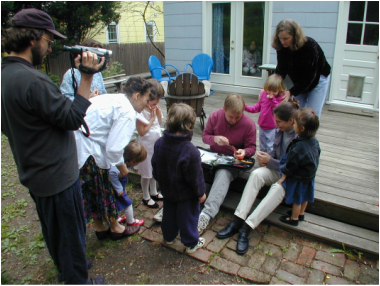
Do city-dwelling birds live as long as country-dwelling birds? Do they raise as many offspring? Neighborhood Nestwatch, a citizen science project of the Smithsonian that began 15 years ago in Washington, DC, is set up to answer these questions. This year, in partnership with the North Carolina Museum of Natural Sciences, Neighborhood Nestwatch is coming to North Carolina.
During April, May, and June, the scientists of Neighborhood Nestwatch will visit homes to capture, measure, and band birds and search for their nests. Participants can help during the visits and are coached on how to collect and report later sightings of banded birds and nesting outcomes on their own. Data collection by participants is crucial to the success of the project. Each bird on the Nestwatch species list receives a unique combination of color-band bracelets on their legs. Scientists teach participants how to find banded birds and record their color combinations to tell individual birds apart. Participating is a multi-year commitment and you’ll be able to find out whether you wake to the same individual mockingbird in your yard every year.
The study area encompasses all or part of the following counties in North Carolina: Rockingham, Caswell, Person, Granville, Vance, Warren, Northampton, Halifax, Edgecomb, Nash, Franklin, Wilson, Pitt, Greene, Lenior, Wayne, Duplin, Sampson, Johnston, Bladen, Robeson, Cumberland, Harnett, Hoke, Moore, Lee, Scotland, Richmond, Montgomery, Randolph, Chatham, Guilford, Alamance, Orange, Durham, and Wake. Plus a little of southern Virginia: Pittsylvania, Halifax, Mecklinburg, and Brunswick counties.
If you are interested in volunteering, please follow this LINK to sign up.
Please note that more people may sign up than we can accommodate this year. For research goals, we want an equal distribution of urban, suburban, and rural locations. We will notify you about your selection by late April.
During April, May, and June, the scientists of Neighborhood Nestwatch will visit homes to capture, measure, and band birds and search for their nests. Participants can help during the visits and are coached on how to collect and report later sightings of banded birds and nesting outcomes on their own. Data collection by participants is crucial to the success of the project. Each bird on the Nestwatch species list receives a unique combination of color-band bracelets on their legs. Scientists teach participants how to find banded birds and record their color combinations to tell individual birds apart. Participating is a multi-year commitment and you’ll be able to find out whether you wake to the same individual mockingbird in your yard every year.
The study area encompasses all or part of the following counties in North Carolina: Rockingham, Caswell, Person, Granville, Vance, Warren, Northampton, Halifax, Edgecomb, Nash, Franklin, Wilson, Pitt, Greene, Lenior, Wayne, Duplin, Sampson, Johnston, Bladen, Robeson, Cumberland, Harnett, Hoke, Moore, Lee, Scotland, Richmond, Montgomery, Randolph, Chatham, Guilford, Alamance, Orange, Durham, and Wake. Plus a little of southern Virginia: Pittsylvania, Halifax, Mecklinburg, and Brunswick counties.
If you are interested in volunteering, please follow this LINK to sign up.
Please note that more people may sign up than we can accommodate this year. For research goals, we want an equal distribution of urban, suburban, and rural locations. We will notify you about your selection by late April.



